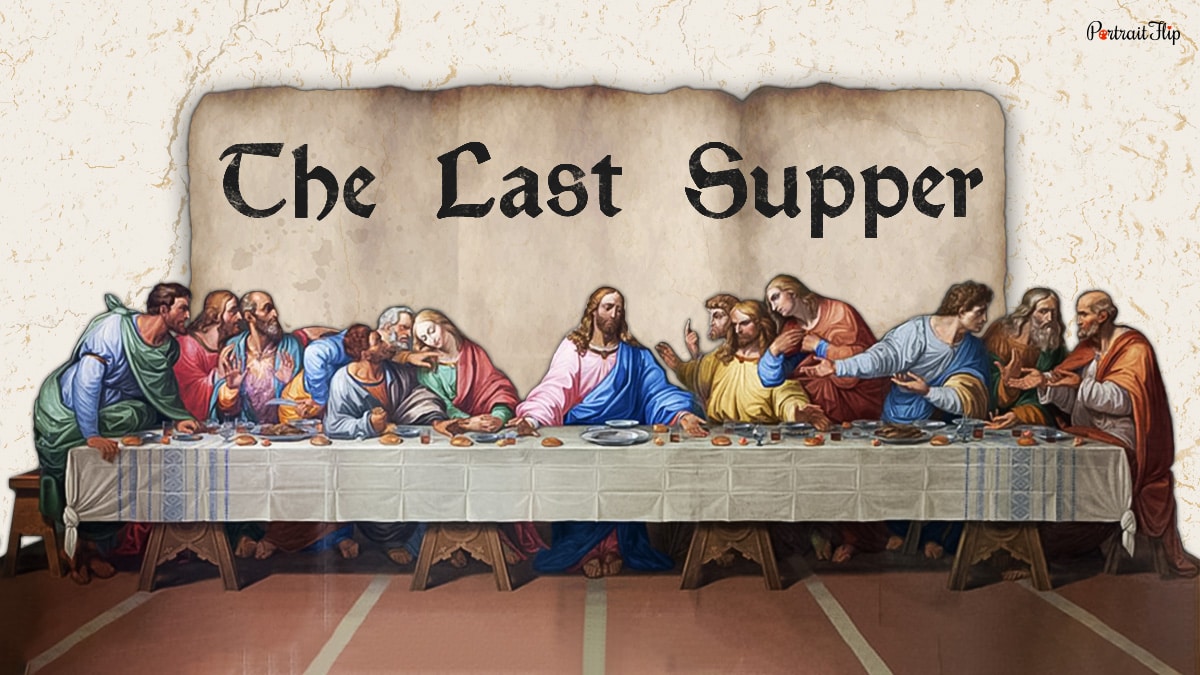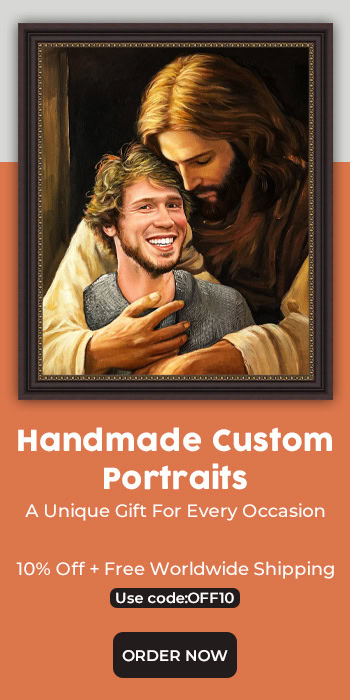In 1495, Leonardo da Vinci began with what later became the most controversial work in the history of art: The Last Supper painting!
A mysterious painting by a famous artist in which a group of people are seen having their meal with weird reactions on their faces.
When we first glanced at the Last Supper painting, we got this eerie vibe, because of its composition and theme.
However, the question that instinctively pops up in mind is what drove Leonardo to paint something around the subject of the last meal? And whose last supper the artist is talking about? Is it the followers of Jesus or Christ himself?
Keep reading the blog as we cover the intriguing stories and facts surrounding the Last Supper painting. And we also put forward our interpretation of the Last Supper painting.
But first, let’s hear a small backstory that led Leonardo to create this beautiful yet tragic art.
Table of contents
- History: What Makes the Last Supper Renowned?
- Analysis: A Deep Dive into the Art
- Restoration: Is The Last Supper Painting Original?
- Characters: The Apostles/ Disciples of Jesus Christ
- Theory: Is The Last Supper Painting by Leonardo a Conspiracy?
- Leonardo’s Technique: Light and Symbolism
- Facts: Hidden Truths About the Art
- In Culture: Recognition it Follows
- Final Words
- Hi Art Lovers
- FAQs
History: What Makes the Last Supper Renowned?
A question for you: what is supper’s definition?
It means an evening meal, which is continued with informal meetings.
This clears up many thoughts about the title of the painting.
But whose Last Supper does it show?
The answer is: Jesus Christ!
The story goes like this: The Last Supper Painting is the portrayal of the last meal of Jesus Christ with his followers.
Christ gathered his disciples for a meal before his arrest and crucifixion.
The scene we see in the Last Supper painting is when Christ tells his followers about the betrayal and says he’ll be leaving them soon.
He said that one of his disciples has betrayed him, and he has gathered them in order to have one last meal with them.
He even washed their feet and taught them how to eat and drink, which will be marked as a remembrance of Jesus Christ.
The disciples’ reactions are already clear from Leonardo’s painting, where they are shocked, angry, and confused.
The Last Supper painting depicts the next few seconds of the story when Christ decided to bombshell his news of crucifixion.
Painting mysteries always contributes to success, as the audience becomes curious to know what exactly took place.
The timing or scene is the important side of the painting, which Leonardo depicted brilliantly.
With the thought of getting deeper into the art, let’s analyze the painting!
Analysis: A Deep Dive into the Art
When an artwork is created, it involves two aspects: the art and the artist.
Let’s acknowledge both!
1. The Italian Painter
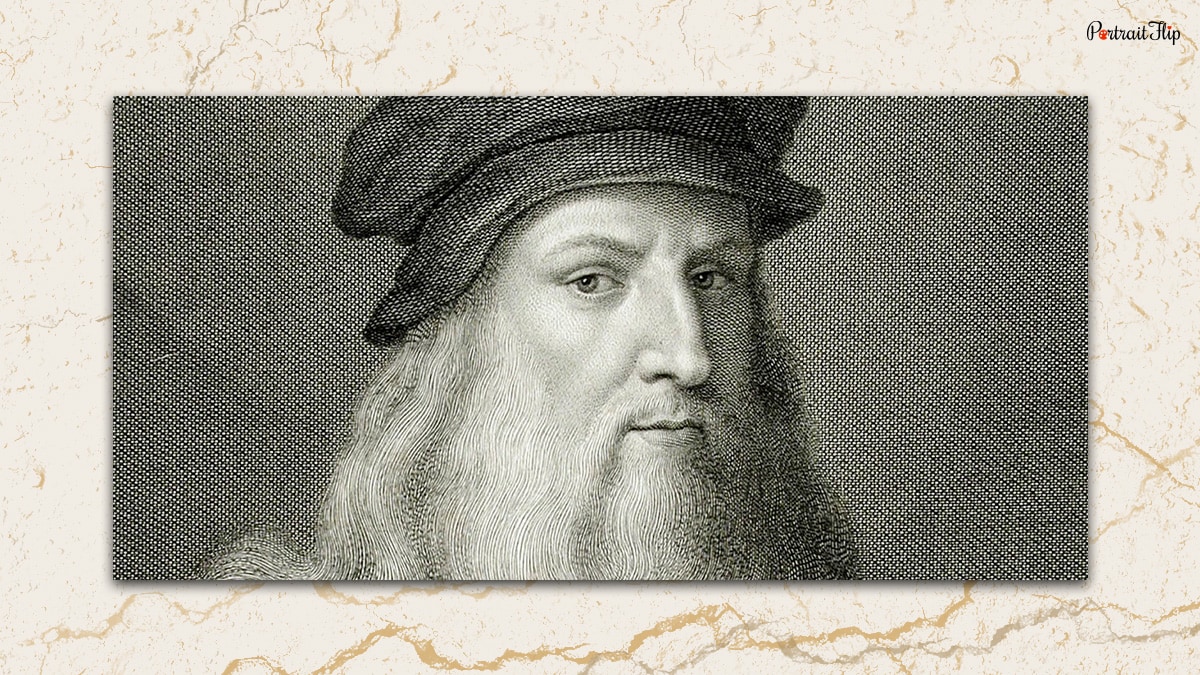
Who doesn’t know Leonardo da Vinci?
A renowned artist who gave the world numerous famous paintings with his masterful artistic mind.
The Last Supper painter and a famous Italian artist during the High Renaissance period.
Apart from being a painter, Vinci was a polymath, which introduces him as an architect, scientist, author, inventor, and humanist.
A man with multiple personalities surely proves Vinci’s thoughts, which led to the creation of many beautiful works of art.
As we all know, his most famous painting, The Mona Lisa, stands out among his fantastic works.
The Last Supper is a testimony to Leonardo’s multifaceted ability to experiment and generate curiosity among the people.
Counted as one of the early Renaissance artists, Vinci was never appreciated in the birthplace of the Renaissance itself.
His work became popular because he always aimed to create art that was either inspired or experienced.
The Last Supper painting was also something that could be considered his inspiration.
But was it an inspiration or a commission?
During his study period, Vinci honed his technical and mechanical skills while mastering artistic techniques, setting the foundation for future innovations.
His early education and apprenticeship shaped him into a visionary, much like how a graduate school essay writer refines their expertise through dedicated learning and practice.
2. A History Painting
What idea did you get when you first saw the Last Supper painting?
- A giant fresco on the wall?
- A masterpiece from the Renaissance period?
- One of Leonardo’s best works?
- A beautiful portrait of Jesus and his disciples?
Da Vinci’s The Last Supper was a depiction of ritual dining as a religious ceremony.
There are various famous paintings by Leonardo, with the original Last Supper painting taking the top spot.
But did you notice one interesting fact: Jesus is exactly placed in the centerpiece, well framed by the doorway?
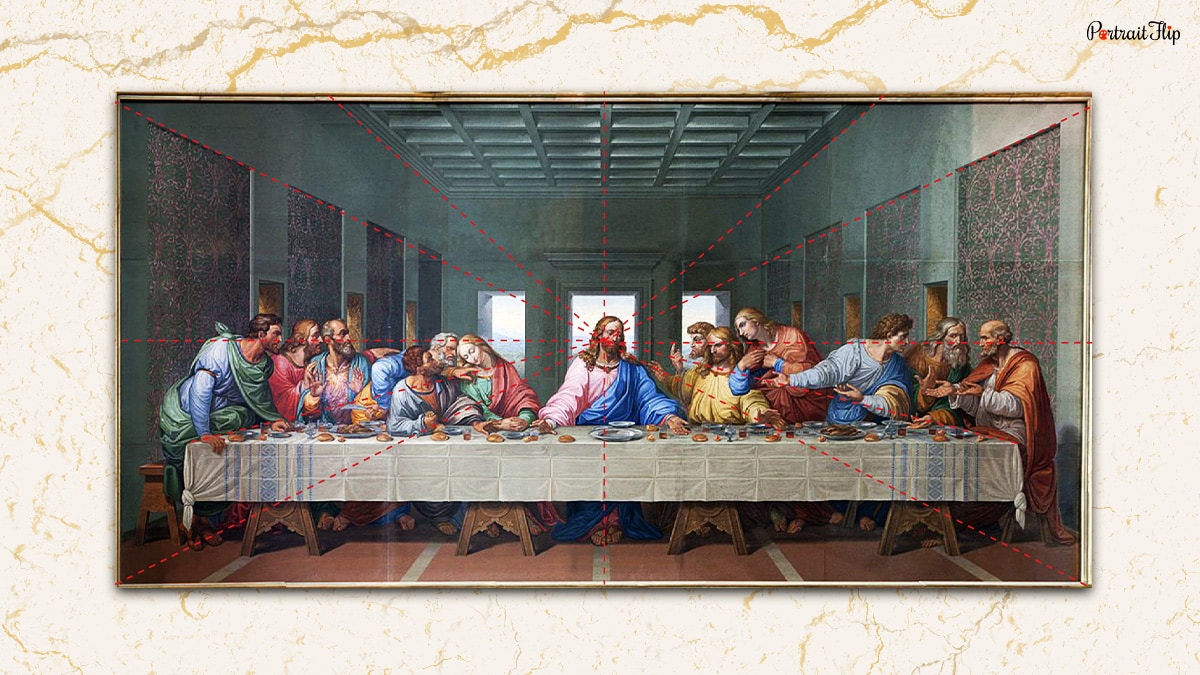
As you can see, Christ has been a focal point in all the places. But what does Leonardo want to depict by keeping him in the center?
He created a contrast between Jesus painting and the outside world, making him the primary character of the painting in the eyes of the viewers.
Even if you look at the artwork, the 12 disciples are also kept at a distance, where it is obvious that Jesus is the host of the ceremony.
Leonardo’s main motive was to make the audience live in the situation where Jesus announced his crucifixion.
He wanted to generate feelings among his viewers about how they would react if they were one of his disciples.
If we analyze the situation that the followers must have been going through during the announcement, your heart will surely ache with the thought.
Do You Know Where The Last Supper was Painted?
Leonardo da Vinci created the original painting of the Last Supper in the refectory of the Dominican convent of Santa Maria delle Grazie.
Leonardo was a genius. You know why?
He knew exactly the weaknesses of the people. He knew what would be the trigger point for the viewers and how to bring out their emotions.
Humans are mostly connected with the painting, which has a huge history to portray and tells a story that is impactful for the audience.
Jesus’ crucifixion was the most sorrowful day for the people. And this led to the Last Supper, a renowned work in the history of painting.
What a masterpiece! But this masterpiece was revamped many times, making us question whether we have the original painting of the Last Supper or not.
Restoration: Is The Last Supper Painting Original?
Yes, Leonardo da Vinci’s The Last Supper is still the original artwork, but it has undergone various changes due to the choice of material used, which we will discuss in later topics.
The piece started to deteriorate after sixty years of production.
The figures in the artwork started to appear quite unrecognizable, making people worry about the damage that was occurring to the piece.
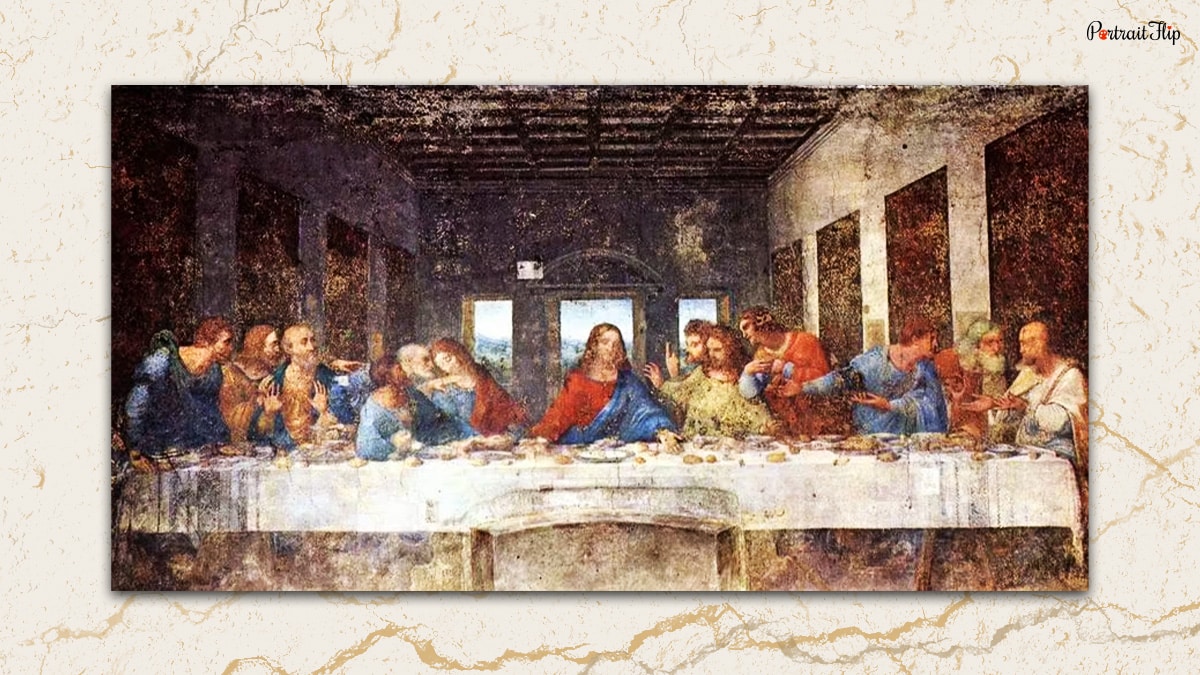
The attempts that were made:
- During the 18th century, a huge curtain was placed to protect the masterpiece from harm. But eventually, it led to more destruction due to the moisture and water.
- The first attempt to restore the painting was made in the 1700s by Michelangelo Bellotti, who filled the missing sections with oil paint, but it didn’t last for a longer period of time.
- Another artist, named Giuseppe Mazza, redone the painting by removing the works done by Bellotti, which also didn’t end well.
- In 1821, Stefano Barezzi, who was an expert at extracting frescoes from walls, was called in to restore the painting. Unfortunately, Barezzi badly damaged the art and later tried to glue down the injury section.
- From 1901-1908, Luigi Cavenaghi completed the study of the structure and began cleaning it, which was further taken over by Oreste Silvestri, who also established some parts of stucco.
The major restoration that took place:
- Pinin Brambilla Barcilon guided the major restoration process from 1978-1999 and helped stabilize The Last Supper painting by reversing the damage caused by pollution.
- This project served as a major attempt, beginning with the decision to move the painting to a climate-controlled environment.
- The detailed study that took place using scientific tests resulted in overcoming the original Leonardo piece of art.
- 21 years of hard work finally paid off in 1999, when the Last Supper painting was all set to be displayed in front of the audience.
Despite the painting being criticized as a not-so-original piece, it made a huge impact in the art world.
Get to learn more about the Last Supper painting restoration from Pinin Brambilla Barcilon herself, who opens up about her own insights and experiences in an interview.
Characters: The Apostles/ Disciples of Jesus Christ
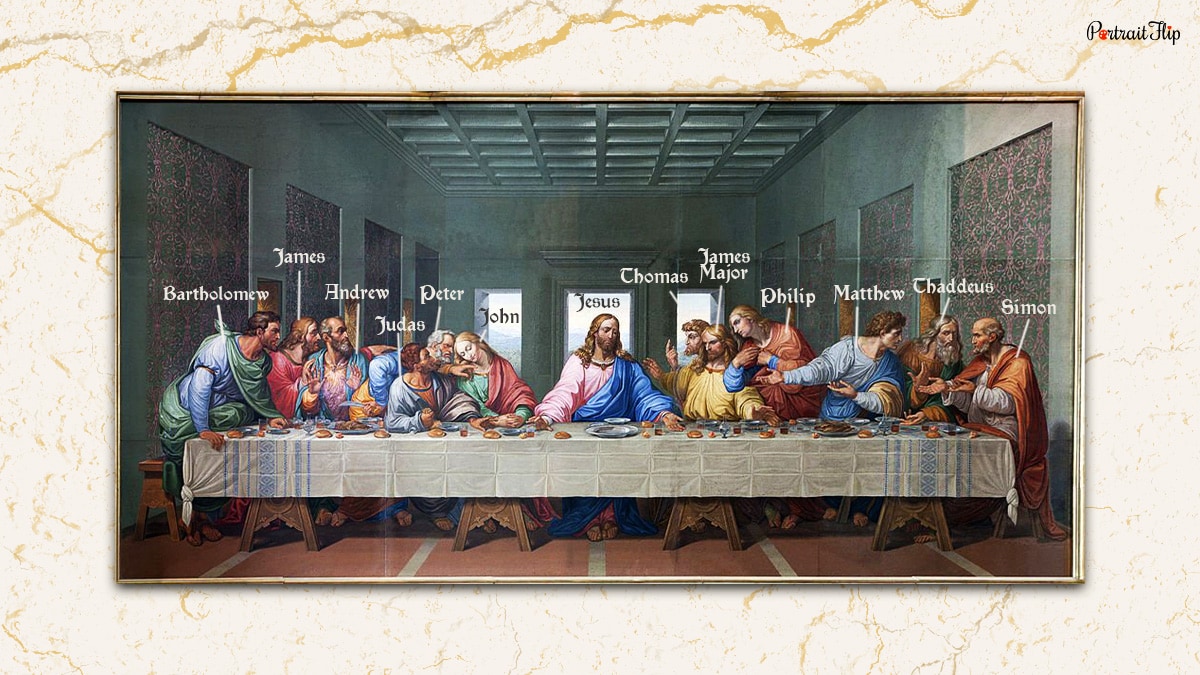
With his hands open and an expression of sorrow on his face, when Jesus announced that one of his followers had betrayed him, each face portrayed a different thought.
The disciples, who are divided into four groups, are stunned by the news they have just received from Christ.
It keeps them wondering who that one follower must have been who betrayed him.
The groups go like this (left to right):
1st Group: Bartholomew, James, and Andrew
2nd Group: Peter, Judas, and John
3rd Group: Thomas, James Major, and Philip
4th Group: Matthew, Thaddeus, and Simon
Group 1:
Bartholomew, James, and Andrew are clearly taken aback by the news announced during the supper.
Their faces and hand positions depict the shock they have received at this unbelievable information.
Group 2:
The trio of the second group, Peter, Judas, and John, who are placed to the left of Jesus, are the most important figures in the painting. Can you guess why?
It is because one of them is the disciple who betrayed Jesus Christ.
But who could it be? With the most shocked and terrified looks on their faces, it surely has to be Judas.
Judas was so petrified by the disclosure of his name that he was not able to move from his place.
If you observe the right hand of Judas, you will notice a bag that indicates the bribe he has taken from the Romans to disclose Jesus’s identity.
Even his head is slightly tilted, and he has the lowest, most obscured face among all the disciples, indicating his disloyal nature.
Group 3:
If we move towards the right of Jesus, the third group, Thomas, James Major, and Philip, are observed with a clearly upset tone and the index finger raised on the decision of crucifixion.
We can clearly make out from their facial expressions and gestures that they are hurt by the news.
The way they are facing Christ shows as if they are seeking an explanation and want to know, “How did this happen all of a sudden?”
Group 4:
Finally, the last group, Matthew, Thaddeus, and Simon, which is on the other end of the corner, is seen facing Simon to know whether he has answers to their questions.
In all the groups, there is one thing in common, which is the terror and shock that they received with the news of the crucifixion.
But an artwork that is so renowned surely adds up to some theories within itself.
Theory: Is The Last Supper Painting by Leonardo a Conspiracy?
You must be wondering what conspiracy theories there would be regarding The Last Supper painting, right?
Let me tell you that this question has various interpretations.
The first conspiracy theory was that Leonardo’s work of art had hidden messages. It is considered a symbol of mystery.
It is believed that the figure sitting to the left of Jesus is none other than Mother Mary.
All the Last Suppers before Leonardo depicted John in a feminine manner, claiming her as Mother Mary.
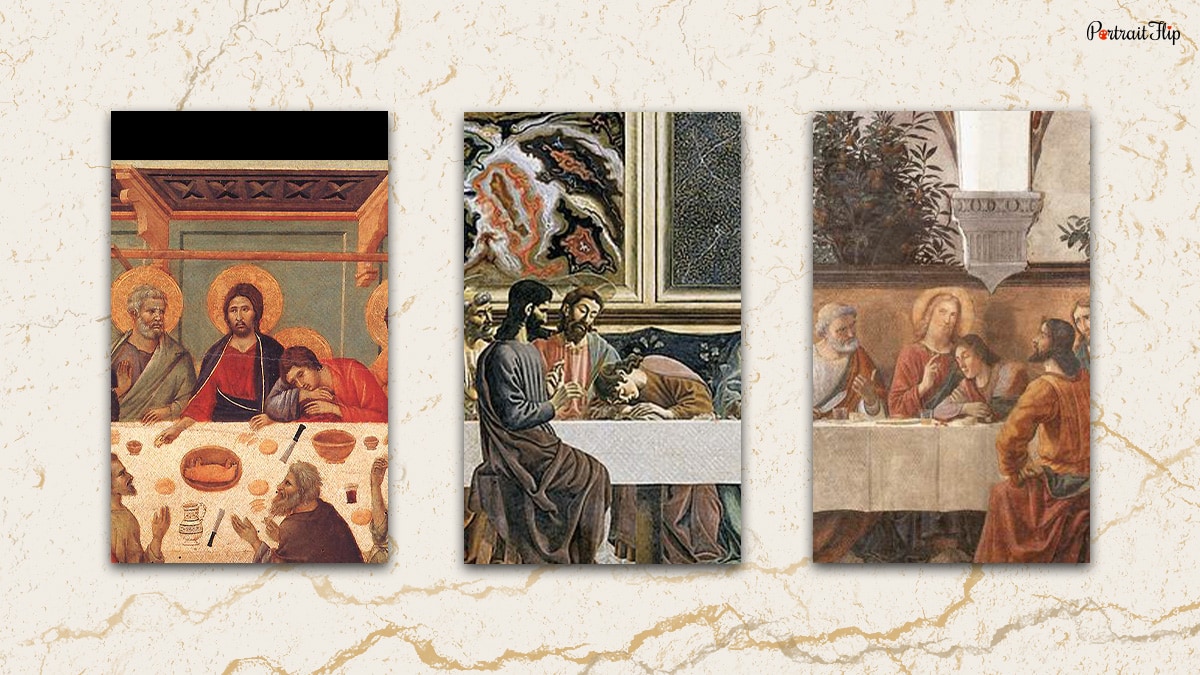
The above image clearly shows the portrayal of Mother Mary in the previous versions of The Last Supper by different artists.
It was believed that John was among the most favorite disciples of Jesus and was known as John the Apostle.
Each artist has their own way of expressing the Last Supper through art.
Leonardo da Vinci was highly influenced by those artworks that depicted John in a feminine way.
This leaves the viewers in a dilemma about whether it is Mother Mary or John the disciple.
Amid this discussion about the painting, what if I ask you to represent your thoughts on the same in the form of an essay?
Well, if you are intrigued by the thought of it then you might like one of the best essay writing services that can help you with the same.
Make sure to explore what all they have to offer.
Leonardo’s Technique: Light and Symbolism
You have already learned about how restoration took place. But what roots led to the deterioration of the painting? This is a common question.
Did a renowned painter like Leonardo use low techniques while producing art? What makes him paint in such a way?
The Last Supper by Da Vinci was never painted as a fresco.
He wanted to experiment with colors that stood out compared to the ones used on frescoes.
He combined mediums like oil paint and tempera to form a double layer of dry plaster.
Leonardo prepared the wall with gesso and a mastic base. He even applied a white undercoat that added light to the paint.
It is a technique used in panel painting.
But eventually, this technique didn’t go as planned by Leonardo and started to affect the painting within a few years.
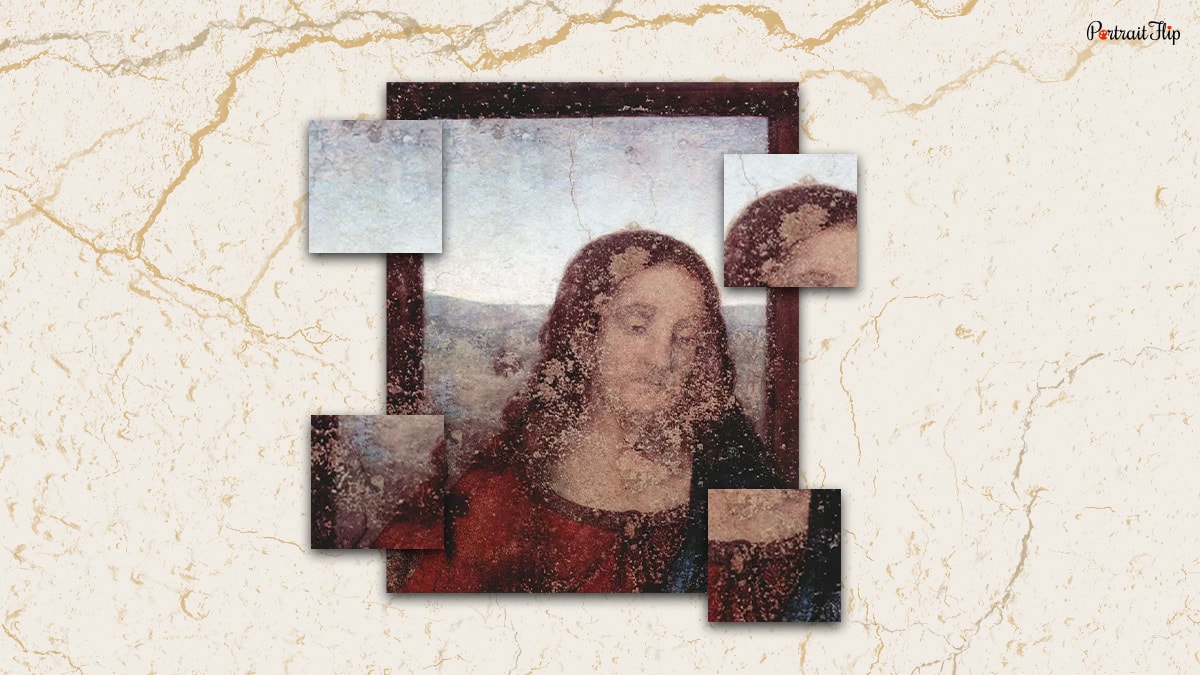
He even used techniques such as chiaroscuro and sfumato, which created visual depth from contrasting colors like dark and light.
It also allowed artists to use excessively bold and sharp outlines.
Leonardo knew how to bring a natural touch to The Last Supper painting, therefore, he used the tools that helped him achieve a hazy yet realistic appearance.
A Geometric Symbolism
It is also believed that the artwork carries geometric symbolism.
Leonardo da Vinci’s Last Supper was painted in such a way that it has a depiction of triangular figures all over it.
As mentioned before, he shaped Jesus as the focal point of the painting, from which all sides are at equal distance.
Another symbolic representation is the number.
Leonardo played with the number “three,” which is also considered the three sides of a triangle.
He was well aware of the symbolism he was playing with that revealed the holy trinity—the Father, the Son, and the Holy Spirit.
What a genius!
Who doesn’t want to bring these genius masterpieces home?
With our Leonardo reproduction paintings, you can now own one of the original copies of Da Vinci’s. Explore now to give your wall an aesthetic look!
Facts: Hidden Truths About the Art
A painting like The Last Supper surely had to have some hidden truths that made it a big success.
But what could it be?
- The Last Supper painting is secure in a climatic environment, which means that the artwork is kept in such a manner that it doesn’t get damaged.
- Despite being painted on the wall, it is not considered a fresco.
- The painting has undergone multiple restorations, leaving very little of Leonardo’s original brushwork.
- Three early copies of the work still exist.
- Da Vinci hammered and nailed the art in order to gain perspective at one-point.
- According to Giovanni Maria Pala, an Italian musician, Vinci incorporated musical notes into the painting.
- The disciple to the left of Jesus is not a woman.
- The original The Last Supper painting was huge in size, measuring 15 feet by 29 feet.
- It is believed that Judas himself modeled for the painting. Leonardo searched for the prison where Judas was kept in order to get a perspective on what a traitor looks like.
- Before painting the final work, Leonardo is said to have made preparatory sketches about how the piece would look. He studied the characters in the first place.
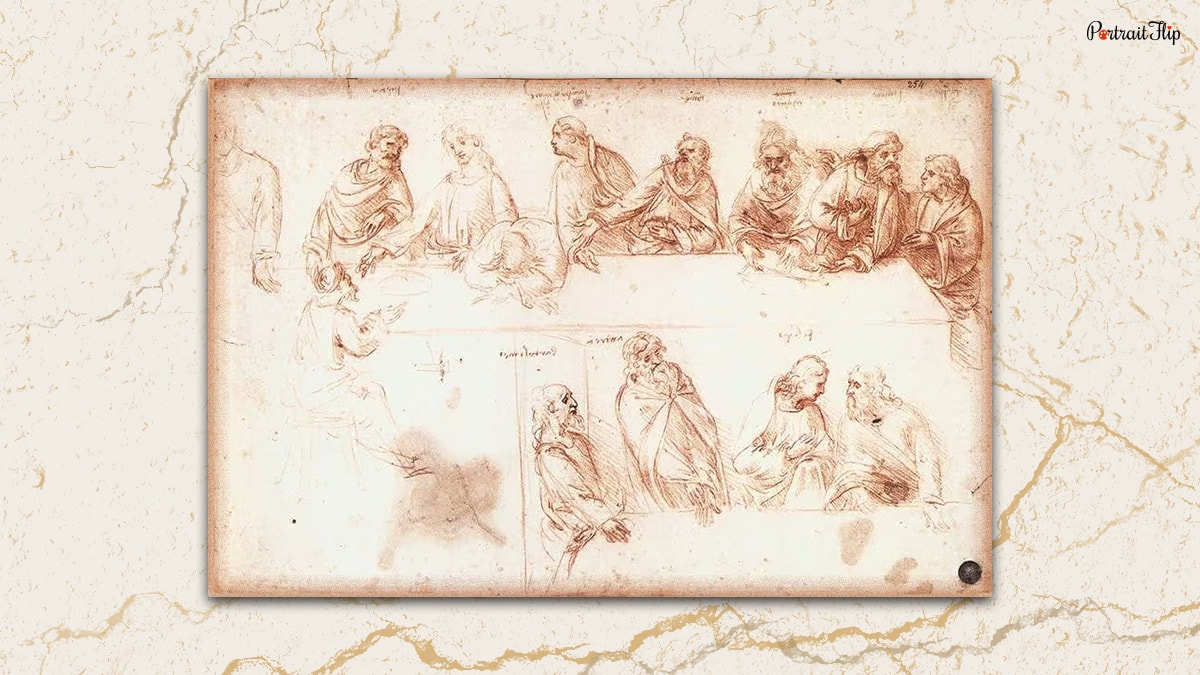
There could be more secrets that add curiosity to the painting, leaving the viewers in a state of awe!
You can also read:
Salvator Mundi, restored treasure by Leonardo, or Creation of Adam by Michelangelo
In Culture: Recognition it Follows
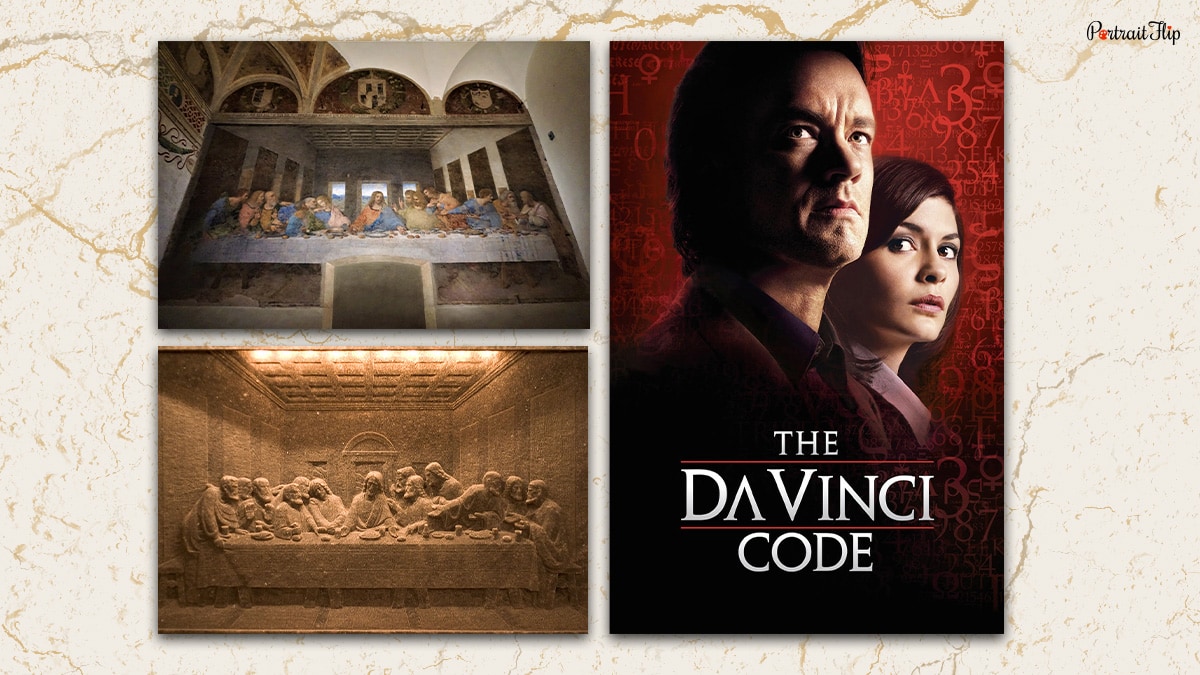
Being one of the famous paintings of Jesus, the artwork has been in western culture for a longer period of time.
It is the most frequently referred to and reproduced painting.
- Giacomo Raffaelli, a famous Roman mosaic artist, made a copy of the painting under the commission of Napoleon Bonaparte.
- One of the paintings by Salvador Dali, namely “The Sacrament of the Last Supper,” was inspired by Leonardo’s The Last Supper.
- Mary Beth Edelson, an American artist and pioneer of the feminist art movement, created Some Living American Women Artists, which is a mockup of the painting The Last Supper.
- Andy Warhol, another American artist, depicted the reflection of the painting in his artwork.
- Even the literature part did not miss the chance to portray such a masterpiece in words. Lydia Sigourney was an American poet who published the painting in her poetry with the same title, “The Last Supper.”
- If we are talking about something famous, then how can the entertainment industry be behind reproduction? The painting is referred to in the film as “Quo Vadis,” or as a parody on a show name, “That ’70s Show.”
- The famous movie “The Da Vinci Code” was an American thriller that depicted the painting in the most vast manner. This movie is banned in a few countries as well.
Now you know about the small parts that made the Last Supper painting by Da Vinci famous.
Final Words
There is one thought that makes the viewer question: Where is the real Last Supper painting?
The answer is: The Church of Santa Maria delle Grazie in Milan, Italy, which holds Leonardo da Vinci’s masterpiece, The Last Supper.
A painting that reflects famous history and background doesn’t make you want to own one?
I am sure it must! Then what pulls you back? Get this masterpiece by Leonardo da Vinci home. Click on the link below and explore the artwork through your eyes.
Hi Art Lovers
Now that you have come to the end of the blog, “The Last Supper Painting,” there must be some questions to ask or suggestions to give.
Enlighten me with your perspective about the painting via comments, or you can also write to me at [email protected].
We will be pleased to learn about the painting through different eyes.
If you are a regular reader of the arts and their artists, then we welcome you to our art and aesthetics page, which will be like finding a treasure for you.
Keep reading and exploring.
See you soon in the next blog!
FAQs
The Last Supper was created by Leonardo da Vinci.
Leonardo likely used familiar faces while creating the artwork, and it was assumed that he portrayed himself in the Last Supper painting.
Yes, the man who grabs the attention of the viewers while sitting in the center of the piece is none other than Jesus Christ.
It was painted between 1495 and 1498, which heralds a new era.
Jesus blessed the disciples, saying, “Take, eat; this is my body.” He even passed a cup of wine, saying, “This is my blood.” Jesus’ words reflect the crucifixion he was about to suffer and give the Last Supper painting meaning.
The painting was almost destroyed when a Royal Air Force bomb struck Santa Maria delle Grazie, which demolished the roof of the refectory during World War II.
The painting measures 180 inches by 350 inches, covering the entire wall.

